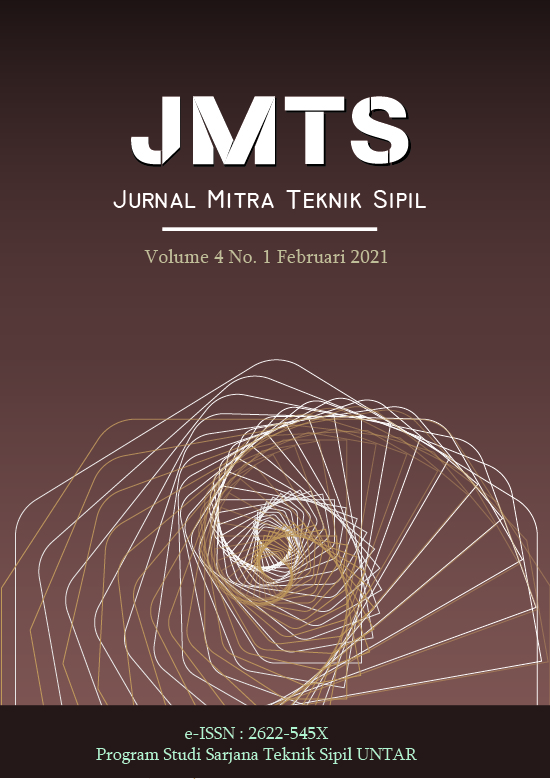ANALISIS SISA MATERIAL DAN PENYEBAB UTAMANYA PADA PROYEK BANGUNAN RUMAH TINGGAL
Main Article Content
Abstract
Material is one of the most important components with a 40-60% contribution of all the project costs. Waste in the construction field can be interpreted as a loss or a loss of material resources, time (about labor and equipment) and capital, which is caused by activities that cost money, directly or indirectly, but does not add any value to the product for users of construction services. This research aims to search for the waste material with the most impact and its percentage, along with the main cause behind the presence of the waste material. This research was conducted by processing primary data in the form of a Likert scale questionnaire. In the process, this research used the Relative Importance Index (RII) method with a significance level of 5% and assisted with Statistical Product and Service Solutions (SPSS) application to test and calculate the data. The result of this research shows that waste material with the most impact is ready mix concrete 10%, reinforcing steel 9.87%, and ceramics 9.5%. The main causes which result in the presence of the waste material are lack of blueprint information, error due to the labor, and the act of abandoning or throwing the material.
ABSTRAK
Material berfungsi sebagai bahan dalam pekerjaan lapangan yang mempunyai peranan sangat penting sebesar 40 – 60% dari seluruh biaya proyek tersebut. Sisa dalam konstruksi dapat kita artikan sebagai kehilangan atau kehilangan sumber daya materi, waktu (dengan melihat tenaga kerja dan peralatan) dan juga modal, hal ini disebabkan oleh aktivitas yang memerlukan biaya, baik secara langsung atau tidak langsung, tetapi sama sekali tidak menambahkan nilai pada produk jasa konstruksi. Tujuan dalam penelitian ini ialah mencari sisa material yang paling mempengaruhi beserta persentasenya dan penyebab utama dari sisa material tersebut. Penelitian ini dilakukan dengan mengolah data primer berupa kuesioner skala Likert. Dalam prosesnya, penelitian ini memakai Metode Relative Importance Index (RII) dengan taraf signifikansi 5% dan dibantu dengan aplikasi Statistical Product and Service Solutions (SPSS) untuk menguji dan menghitung data. Hasil dari penelitian ini mendapati sisa material yang paling mempengaruhi proyek ialah beton ready mix 10%, baja tulangan 9.87%, dan keramik 9.5%. Penyebab utama dari sisa material tersebut ialah informasi gambar yang kurang, kesalahan yang diakibatkan oleh tenaga kerja, dan membuang atau melempar material.
Article Details
References
Apotheker, Steve. "Construction and demolition debris-The invisible waste stream." Resource Recycling 9.12 (1990): 66-74.
Aulia, Novinda Annisa, and Kartika Puspa Negara. "Analisis dan Evaluasi Sisa Material Konstruksi Menggunakan Metode Pareto dan Fishbone Diagram (Studi Kasus pada Proyek Pembangunan Gedung Pascasarjana Universitas Islam Malang)." Jurnal Mahasiswa Jurusan Teknik Sipil 1.2 (2016): PP-649.
Bossink, B. A. G., and H. J. H. Brouwers. "Construction waste: quantification and source evaluation." Journal of construction engineering and management 122.1 (1996): 55-60.
Callister Jr, William D. Mathematics Beyond the Numbers and EGrade V1. 5 Student Learning Guide Set. (2004).
Formoso, Carlos T., et al. "Material waste in building industry: main causes and prevention." Journal of construction engineering and management 128.4 (2002): 316-325.
Gavilan, Rafael M., and Leonhard E. Bernold. "Source evaluation of solid waste in building construction." Journal of construction engineering and management 120.3 (1994): 536-552.
George, J. Ritz. Total construction project management. (1994)
Ghozali, Imam. Aplikasi Analisis Multivariete IBM SPSS 23.
Badan Penerbit Universitas Diponegoro, Semarang (2016).
Illingworth, J. R. Waste in the construction process. (1998).
Kometa, Simon T., Paul O. Olomolaiye, and Frank C. Harris. "Attributes of UK construction clients influencing project consultants' performance." Construction Management and economics 12.5 (1994): 433-443.
Liman, Kevin, and Hendrik Sulistio. "Waste Material Beton Pada Proyek Konstruksi Di Jakarta." JMTS: Jurnal Mitra Teknik Sipil 3.1 (2020): 183-190.
Mincks, W. R. The construction contractor’s waste management plan: optimizing control and cost. Sustainable construction. First Conference of CIB TG. Vol. 16. 1994.
Mulyadi, Mulyadi. "Menyongsong Pergeseran Peran Profesi Akuntan Manajemen Dalam Era Teknologi Informasi." Journal of Indonesian Economy and Business 15.2 (2000): 225-246.
Waty, Mega, et al. "Modelling of waste material costs on road construction projects." (2018).



